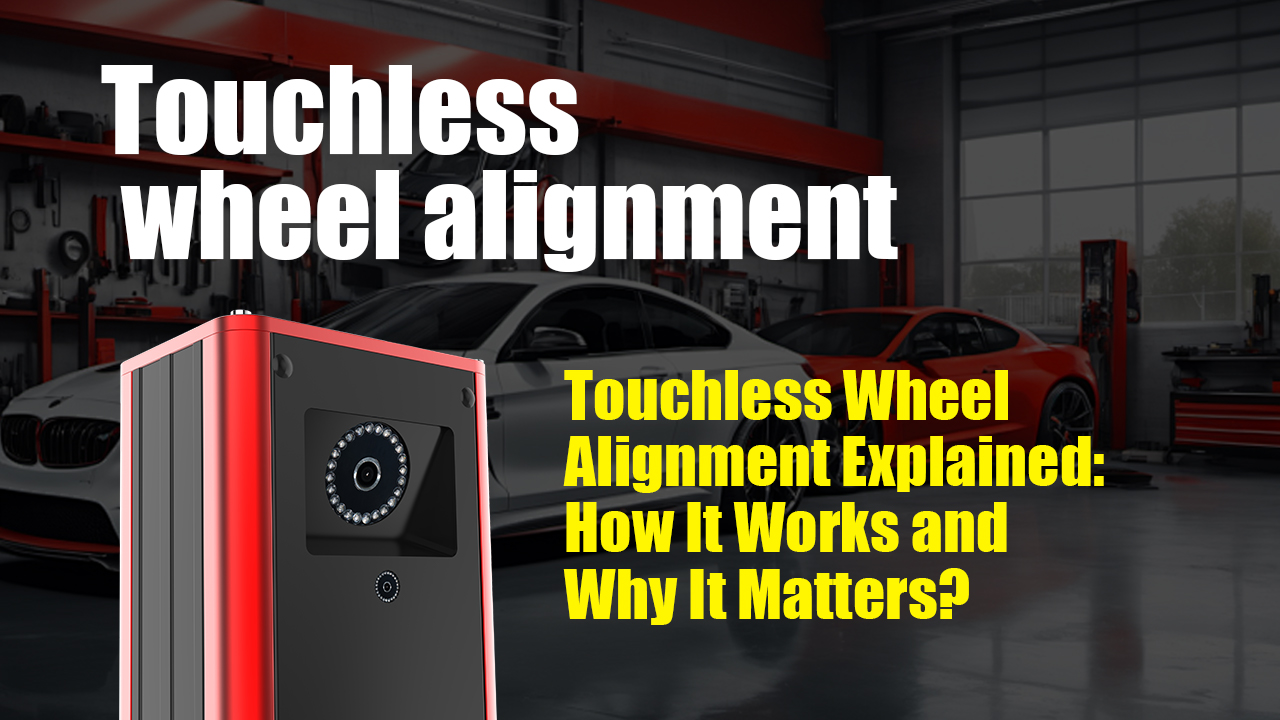Touchless Wheel Alignment Explained: How It Works and Why It Matters?
Introduction:
In today’s fast-paced automotive service industry, speed, precision, and efficiency are more critical than ever. For repair shops specializing in wheel alignment, touchless wheel alignment system has become a powerful helper for it to save time, reduce labor and improve accuracy. Unlike the traditional method that relies on physical contact with the wheel, this advanced technology uses cutting-edge sensors and software to provide unparalleled accuracy. In this blog, we will explain how touchless wheel alignment works and why it is important for both automotive professionals and shop owners.
What Is Touchless Wheel Alignment?
Touchless Wheel Alignment refers to an wheel alignment system that does not require any physical contact with the vehicle’s wheels or body. It is a modern method of measuring and adjusting a vehicle’s wheel angles (camber, toe, and caster) without physically attaching sensors or clamps to the wheels. Instead, it uses 3D imaging, laser scanning, or optical sensors to capture real-time data, ensuring a faster, safer, and more accurate alignment process.
The contactless wheel aligner does not require the removal and installation of wheel clamps and targets like traditional four-wheel aligners, which can avoid damage to the rim during the measurement process. At the same time, this technology does not require cart compensation. These advantages can help automobile repair and maintenance companies reduce work intensity and greatly improve measurement efficiency.
How Does Touchless Wheel Alignment Work?
The technology behind touchless wheel alignment systems eliminates the need for manual adjustments or bulky equipment. Here’s a simplified breakdown of the process:
Vehicle Positioning
Drive the vehicle to be tested between the pillars equipped with sensors and cameras, and ensure that it is aligned horizontally with the vehicle so that multiple laser 3D scanners can measure. Then, view the camera monitoring through the software interface and adjust the parking position until the marks of the four wheel positions in the image are all green.
Vehicle Information Input
In the software operation interface, select the correct vehicle manufacturer, model and other related information.
Automatic Scanning
Follow the steps on the software interface and swing the steering wheel in sequence. At the same time, the high-resolution camera and sensor will start immediately to scan the wheels and body, and present the 3D model of the car suspension and wheels on the software interface. Note: Before starting the measurement, make sure to fix the brake pedal, tighten the handbrake, and remove the steering wheel bracket.
Real-Time Data Analysis
The software of the system computes wheel alignment angles, including toe, camber, and caster, in real-time without requiring any input from the operator.
Display of Alignment Results
Results are displayed instantly on the screen, allowing technicians to analyze the current alignment status and recommend necessary adjustments.
Adjustment (if needed)
Following the analysis, technicians are able to carry out alignment adjustments either manually or automatically as necessary.
Verification
Post-adjustment, the system re-scans the wheels to confirm alignment accuracy. Finally, after completing the measurements and adjustments, we can save and print all the measurement data.
Why Touchless Wheel Alignment Matters?
For auto repair shops and technicians, investing in touchless wheel alignment technology offers significant competitive advantages:
Higher Precision Data
Advanced camera systems and software algorithms provide more accurate and repeatable measurements compared to manual systems.
Faster Measurement Speed
With no need to mount or remove clamps, the alignment process becomes significantly faster, allowing shops to serve more customers daily.
Improved Workflow Efficiency
During the measurement process, technicians do not need to perform run-out compensation. Instead, they can focus more on customer service.
Reduced Risk of Wheel
No physical contact means no scratches or damage to expensive alloy wheels or sensitive sensors, which is especially important for luxury vehicles.
Wider Application Range
Works seamlessly with all vehicle types, including EVs, trucks, and low-profile tire setups.
Professional Image and Customer Trust
Using cutting-edge tools like No-contact Wheel Alignment systems can impress customers and build trust in your service quality.
Is Touchless Wheel Alignment Right for Your Workshop?
If your business deals with a high volume of vehicles or you serve high-end clients, investing in a Touchless Wheel Alignment system could be a smart move. Although the initial cost is higher than traditional systems, the time saved, improved accuracy, and enhanced customer experience can offer a strong return on investment.
Conclusion
Touchless Wheel Alignment represents the future of wheel servicing. By eliminating contact, it not only protects the vehicle but also improves speed and precision in your workflow. Whether you operate an independent garage or a large-scale service center, adopting touchless technology can elevate your business to the next level.
Explore the accuracy, speed and reliability of the GATmatic GA-800 series touchless wheel alignment system design. Contact us today to learn more about our advanced automotive diagnostic and alignment solutions.
Describe Your Needs In Detail!
We will carefully evaluate your needs and give professional solutions.



